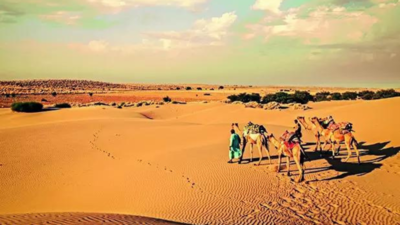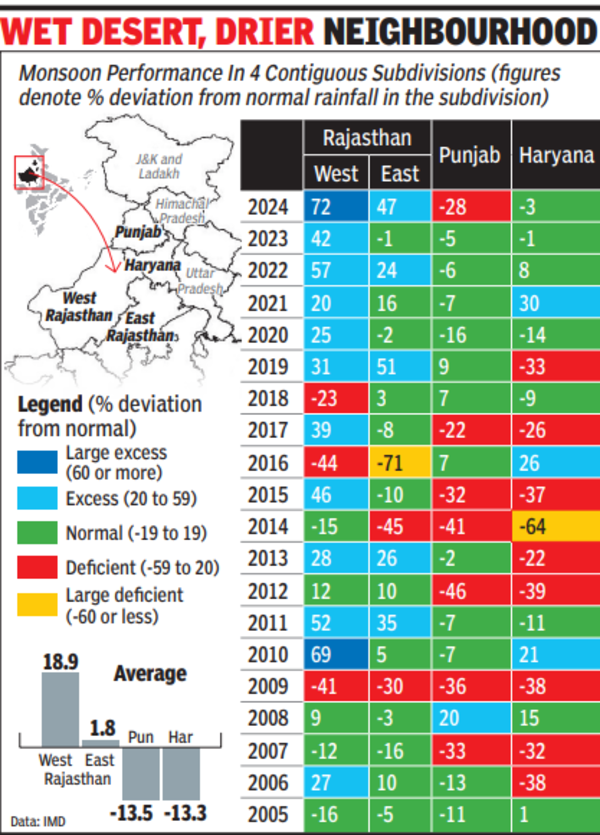NEW DELHI:
West Rajasthan
, land of
Thar desert
and the driest region in
India’s plains
, was among two subdivisions out of 36 that received
excess rainfall
during this monsoon. Surprisingly, this was hardly an unusual monsoon for west Rajasthan, which has been getting higher-than-normal rainfall for at least the past two decades in an indication of shifting
monsoon patterns
in a warming world.
As per
IMD data
analysed by TOI, west Rajasthan has got above-normal or excess monsoons for six years in a row. In last 20 years, June-Sept rain there has been excess/above normal in 12 years, normal in five and deficient in three. On average, monsoon has been 19% above normal during 2005-2024. Just how exceptional this kind of rain is in region can be gauged through a comparison with two contiguous subdivisions, Punjab and Haryana, during this period.
‘With warming climate, Rajasthan to get more rains’
Just how exceptional this kind of rainfall is in the region can be gauged through a comparison with two contiguous subdivisions, Punjab and Haryana, during this period. Punjab registered just one above-normal year, 12 normal years and seven years when monsoon was deficient, that is, 20% or more below normal. On average, the June-Sept rainfall was 13.5% below normal in the state during 2005-2024.
Haryana’s monsoon pattern resembles that of Punjab. Since 2005, it has seen three above-normal years, eight years of normal rainfall and as many years of deficient rains. In addition, monsoon was ‘large deficient’ (or scanty) in one year. On average, monsoon has been 13.3% below normal in these 20 years.
Even in India as a whole, monsoon during this period has on average been 1.5% less than normal.
However, it must be noted that, being the driest subdivision (SD) in the country, the ‘normal’ rainfall figure for west Rajasthan is significantly lower than that of the other two SDs — 283.6mm at present as compared with 439.8-mm in Punjab and 430.7mm in Haryana.
Yet, the divergence is significant and in several recent years west Rajasthan has received higher rainfall even in absolute terms than either Punjab or Haryana.
“Rainfall over Rajasthan and Punjab-Haryana is decided by the position of the monsoon trough and the westward movement of low-pressure systems in the rainy season. During recent years, we have seen that the monsoon trough was positioned south of its normal position with more westward movement of low-pressure systems. In such situations, Rajasthan gets more rain and Punjab-Haryana less,” explained M Rajeevan, veteran meteorologist and former secretary of the Union earth sciences ministry.
Rajeevan said the region could be drawing rain-bearing clouds towards itself due to changes in soil moisture, land use patterns and, possibly, the addition of water bodies in recent decades, such as the Indira canal.
“Local soil moisture feedback over Rajasthan also helps to tie-up the monsoon trough in that position and attract more low-pressure systems over that region. There is growing evidence of increasing soil moisture in Rajasthan and its interaction with monsoon,” he said.
Finally, more rain over the Thar desert in recent years may just be a sign of things to come in an era of climate change. Said Rajeevan, “Future climate projections suggest Rajasthan and its desert will get more rain in a warming climate.”



